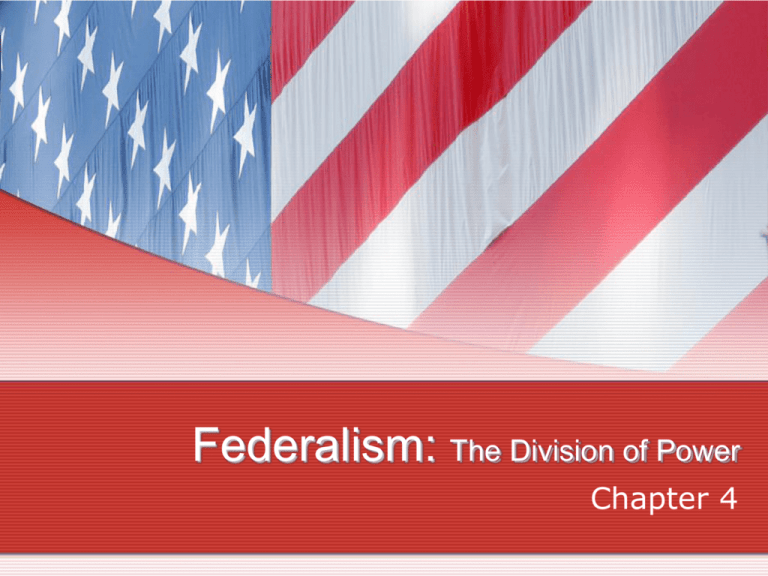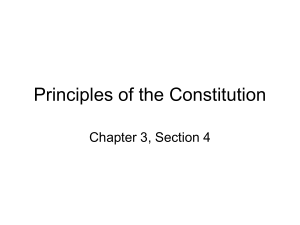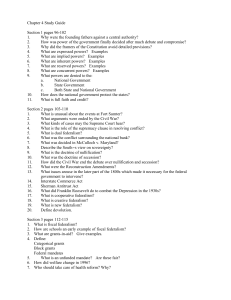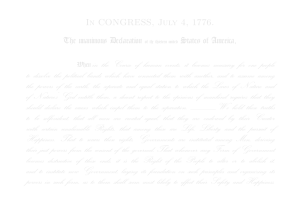Federalism
advertisement

Federalism: The Division of Power Chapter 4 Defining Federalism • Why is Federalism So Important? • Decentralizes our politics • More opportunities for citizens to participate • Decentralizes our policies • Gives Federal & state the choice of which government should take care of which problem • States can solve the same problem in different ways Government Powers (Division of Powers) Expressed Powers Granted Implied Inherent Delegated Powers 10th Amendment Reserved Powers Concurrent Powers National Government State Government Denied Both Denied States Denied National Powers Denied Government Powers (Division of Powers) Expressed Powers Granted Expressed: Implied Inherent Delegated Powers Spelled out in the Constitution •Article I, Section 8 National Government •18 clauses giving 27 powers •Tax •Coin money •Regulate trade •Declare war •Grant patents Government Powers (Division of Powers) Expressed Powers Granted Implied: Implied Inherent Delegated Powers National Government Not written in Constitution, but reasonably suggested •Article I, Section 8, Clause 18 •“necessary and proper” •The Elastic Clause •Build dams •Highways & roads •Determine crimes Government Powers (Division of Powers) Why is the Necessary and Proper Clause called the elastic clause? Government Powers (Division of Powers) Why is the Necessary and Proper Clause called the elastic clause? Over time, it has stretched to cover so many implied powers Government Powers (Division of Powers) Expressed Powers Granted Inherent: Implied Inherent Delegated Powers Not written in Constitution, but belong to national governments •Regulate immigration National Government •Grant diplomatic recognition to nations •Protect the nation Government Powers (Division of Powers) Denied: Expressly denied: •Infringe on rights (speech, press, etc.) National Government Silence in Constitution: •Only has delegated powers Denied in Federal System: •Can’t tax states Denied National Powers Denied Government Powers (Division of Powers) Powers Granted Reserved Powers: 10th Amendment •Not granted to Federal, but not denied to states. •Legal marriage age •Drinking age •Professional license •Confiscate property The power of the state to protect and promote public health, the public morals, the public safety, and the general welfare. Reserved Powers State Government 10th Amendment Government Powers (Division of Powers) Denied States: Constitution denies certain powers to state, because they are NOT a federal government. •Make treaties State Government •Print money •Deny rights to citizens Denied States Powers Denied Government Powers (Division of Powers) Powers Granted Concurrent Powers National Government Concurrent: State Government Both States and National Deniedhave Boththese powers May be exercised separately and simultaneously •Collect taxes •Define crimes •Condemn or take Powers private Denied property for public use Government Powers (Division of Powers) Denied Both: Powers Granted Both States and National have been denied these powers •Violate rights of citizens Concurrent Powers National Government State Government Denied Both Powers Denied Government Powers (Division of Powers) Expressed Powers Granted Implied Inherent Delegated Powers 10th Amendment Reserved Powers Concurrent Powers National Government State Government Denied Both Denied States Denied National Powers Denied The Supremacy Clause (Article VI, Section 2) United States Constitution If there is a conflict between a lower law and a higher one, the higher one “wins.” Acts of Congress State Constitutions State Statues (laws) City and County Laws The U.S. Constitution is the “Supreme Law of the Land.” Constitution, Fed Gov’t and 50 States Federal Govt and State Govts Constitution, Fed Gov’t and 50 States Constitution protects states against internal disorder/disaster Constitution, Fed Gov’t and 50 States FEMA Federal Emergency Management Authority Understanding Federalism Figure 3.4 (1999 average: $6,734) Constitution, Fed Gov’t and 50 States The Types of Federalism Intergovernmental Relations Today • Dual Federalism • Definition: A system of government in which both the states and the national government remain supreme within their own spheres, each responsible for some policies. • Like a layer cake • 16th Amend- income tax • 17th Amend- direct elec. of Senate - 10th Amendment * Reserved powers - Court reinforces – McCulloch (implied powers) & Gibbons (interstate commerce) Intergovernmental Relations Today • Cooperative Federalism • Definition: A system of government in which powers and policy assignments are shared between states and the national government. • Shared costs • Shared administration (fed/state/local) • States follow federal guidelines - Marble cake Intergovernmental Relations Today Devolution Intergovernmental Relations Today • New Federalism - During Reagan & G.W.Bush admin (1980-92) * stronger role of states * used block grants to move responsibility of some programs from federal to state decisions are closer to the people– ex. Welfare This is called the devolution revolution Intergovernmental Relations Today - Devolution Revolution – power back to states (1994 – today) * Unfunded Mandates Reform Act 1995 – Congress can’t make states fund programs Congress passes (eg: Clean WaterAct) * Fed. Programs moved to states where the decisions are closer to the people– eg: Welfare Intergovernmental Relations Today • New Federalism (cont’) - W. Bush Administration & Federalism * Committed to devolution but. * Growth of federal Govt (9-11)– eg: Homeland Security / War in Iraq * NCLB – underfunded mandate Intergovernmental Relations Today How do the states pay for these programs? Intergovernmental Relations Today • Fiscal Federalism • Definition: The pattern of spending, taxing, and providing grants in the federal system; it is the cornerstone of the national government’s relations with state and local governments. Figure 3.2 Intergovernmental Relations Today • Fiscal Federalism • The Grant System: Distributing the Federal money • Revenue Sharing: Federal State of VA receives a % of tax money from the federal govt to use for state projects • Ex: national park revenues are split b/w fed and states 50-50 to be used for national forest trail and road repair Intergovernmental Relations Today • Fiscal Federalism • The Grant System: Distributing the Federal money • Categorical Grants: Federal grants that can be used for specific purposes. They have strings attached • Types: • Project Grants- based on merit • Block Grants: amount varies based on formulas Intergovernmental Relations Today • Fiscal Federalism • The Grant System: Distributing the Federal money • Project Grant: Federal grants that can be used for specific purposes. They have strings attached • Project Grants- based on merit • Henrico County Public Schools applying to fed govt for grant to help with school budget – maybe to bring in more technology which is one of the federal aims Intergovernmental Relations Today • Fiscal Federalism • The Grant System: Distributing the Federal money • Block Grants: Federal grants given more or less automatically to support broad programs but have some strings attached • Grants are given to states & local governments • Fed govt gives VA lump sum which is to be used to fund repairs on VA road system Interstate Relations About that money…. Intergovernmental Relations Today • Fiscal Federalism • The Scramble for Federal Dollars • $300 billion+ in grants every year • States sometimes compete for dollars Intergovernmental Relations Today • Fiscal Federalism • The Mandates of the Federal Govt. • Compulsory laws/regulations passed by Congress (ADA) • Funded mandates • Unfunded mandates • Underfunded mandates Intergovernmental Relations Today • Fiscal Federalism The Mandates of the Federal Govt. Funded mandates compulsory regulation, with money to help defray costs Intergovernmental Relations Today • Fiscal Federalism The Mandates of the Federal Govt. Unfunded mandates are requirements on state & local governments- but no money* Unfunded Mandates Reform Act 1995 – Congress can’t make states fund programs Congress passes (eg: Clean WaterAct) Intergovernmental Relations Today • Fiscal Federalism The Mandates of the Federal Govt. Underfunded mandates have some money but not enough to carry out program so there is a cost to states Interstate Relations About that money…. Interstate Relations grants in aid blur line b/w fed and state because fed govt can act in areas the constitution does not give it authority to like education and mental health. critics - this gives fed govt major voice in making public policy on state level The Constitutional Basis of Federalism States’ Obligations to Each Other & Federal Govt The Constitutional Basis of Federalism Article IV: * Full Faith and Credit * Extradition * Privileges and Immunities (citizens in every state have same rights) *this is why colleges can charge more for out of state student tuition Understanding Federalism • Advantages for Democracy • Increasing citizen access to government • Local problems can be solved locally • Hard for political parties / interest groups to dominate ALL politics • Disadvantages for Democracy • States have different levels of service • Local interest can counteract national interests • Too many levels of government- too much money Understanding Federalism • Federalism and the Scope of Government • Which level of government is best able to solve the problem? • Which level of government is best able to fund solutions to the problem?






